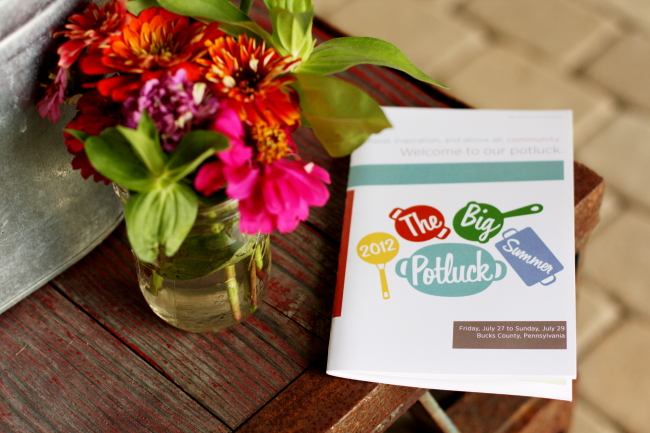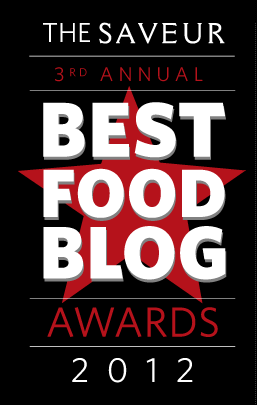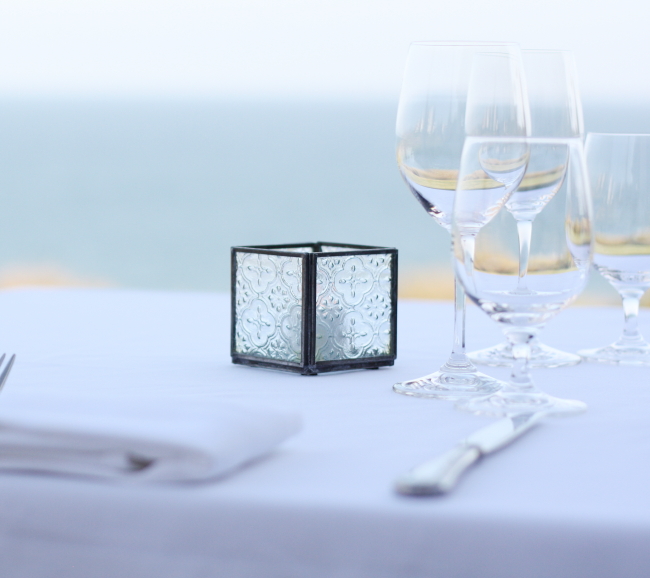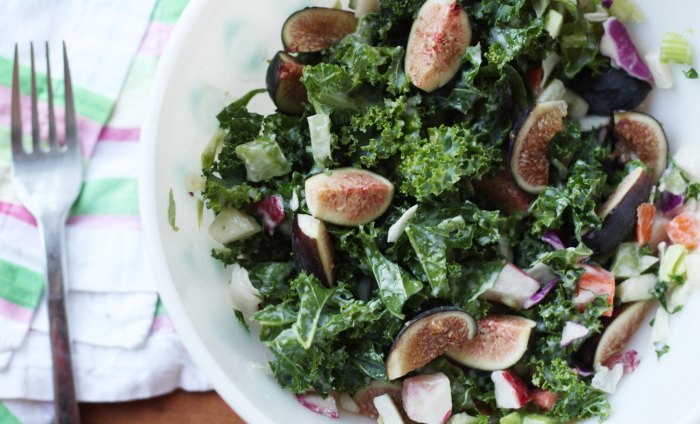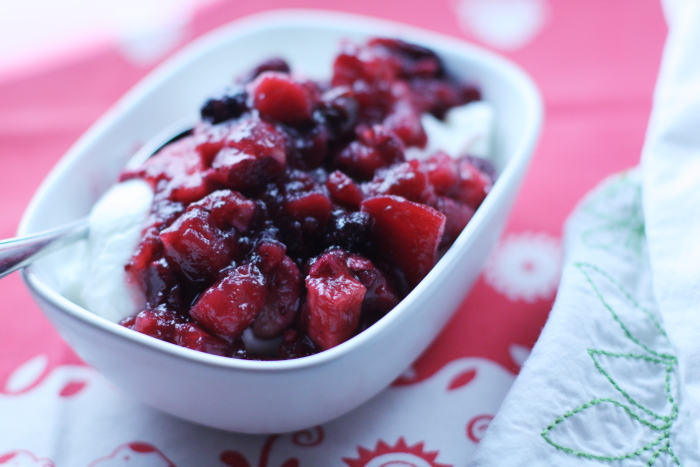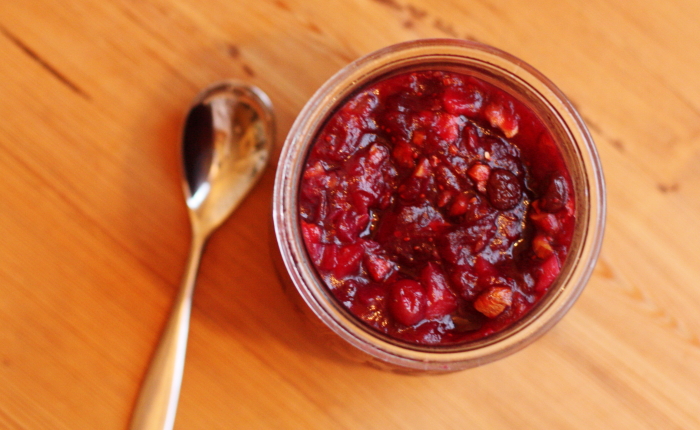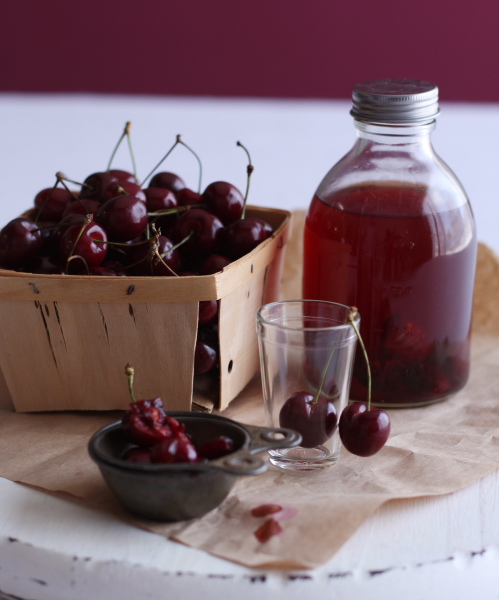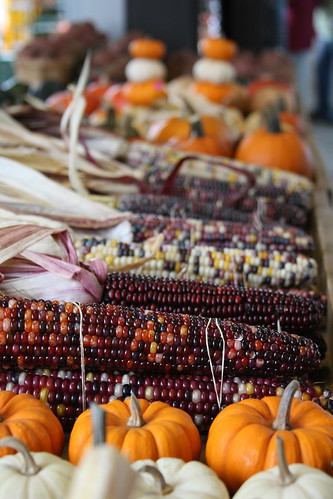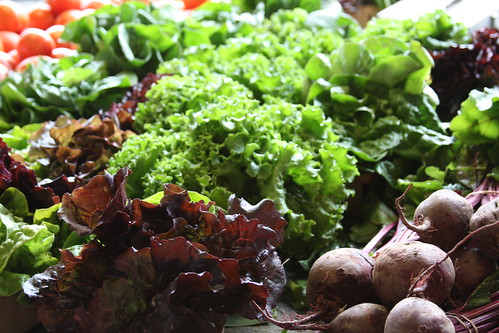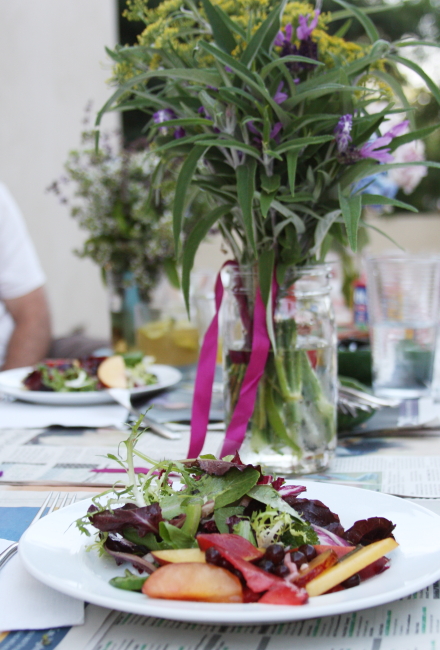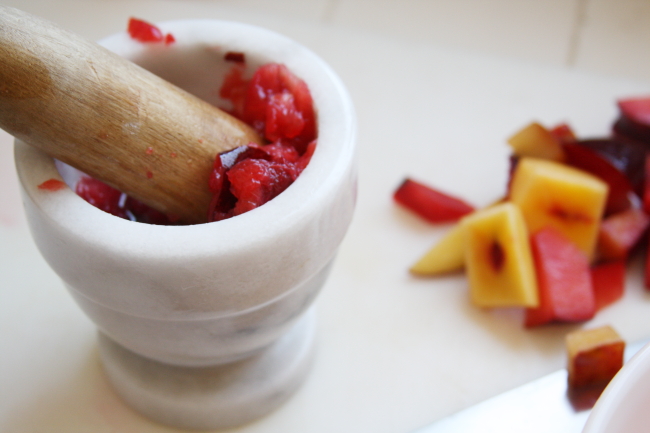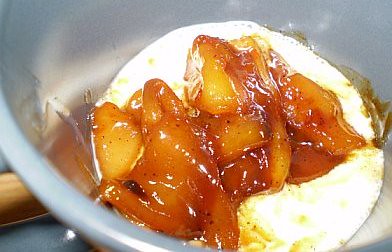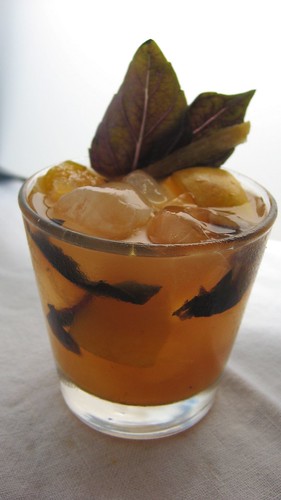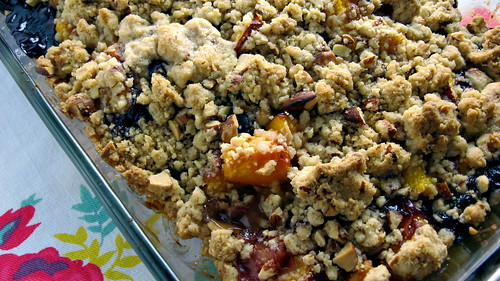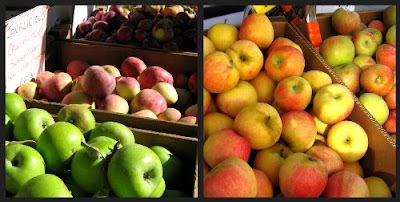
PRESS RELEASE (Los Angeles) Saturday, September 20th. Celebrating the launch of the Foodbuzz.com, an Internet food blog community, 24 featured publishers from around the world simultaneously participated in an array of culinary events across the globe.
One such event included two food bloggers, Food Woolf.com and SpicySaltySweet.com. The two bloggers—-both writing partners and Food Buzz featured publishers, battled it out in the kitchen in an Iron Chef-styled challenge.
Without the aid of sous-chefs or an arena-sized kitchen, the two Los Angeles-based food writers challenged themselves in a timed cooking challenge inspired by the bounty of produce available at the Santa Monica Farmers market. The challengers had two hours to prep, cook and plate three dishes focused on one main fall ingredient: Apples.
Dishes were presented to a panel of food lovers and food industry professionals and the trio of courses were evaluated on taste, plating and originality.
The judges deliberated over scores and, after some discussion, revealed the winning chef and her slim three point lead score. Food Woolf, also a long time friend and writing partner of Spicy Salty Sweet, was quick to point out to all involved how close the scores were.
“It’s not about who’s the better chef. It’s about whose dishes came out great this one day.”
Battle Apple

The challengers:
Food Blogger–Food Woolf (aka Brooke Burton)

Stats
From: Newbury, Massachusetts
Food Blog: Foodwoolf.com
Current job: writer, waiter
Cuisine: Farm driven American/European
Interests: eating, photographing food, reading cookbooks, hiking Runyon Canyon,
Ideal secret ingredient: bacon
Culinary inspirations: Nancy Silverton, Alice Waters, Mario Batali and farmers
Ideal judge: An enthusiastic eater
Culinary secret weapon: Passion!
Favorite restaurant: Pizzeria Mozza, Chez Panisse Café, Hungry Cat
Favorite food: Do I have to choose just one?
Food you won’t go near: food with a shelf life of over twenty years (think Twinkies)
Favorite food destination: Italy
Alternative food job: cook, restaurant owner
HER CHALLENGER:
Food Blog: www.spicysaltysweet.com

Current job: food & wine writer
Cuisine: Mediterranean
Interests: Cooking, eating traveling, hiking, camping, drinking and making wine
Ideal secret ingredient: tomato
Culinary inspirations: local farmers, Italian grandmas, Nancy Silverton, Mario Batali, Alton Brown
Ideal judge: Anthony Bourdain. He never lies and his critiques are always quotable.
Culinary secret weapon: Homemade ricotta
Favorite restaurant: O Ya in Boston, Pizzeria Mozza, Cyrus in Healdsburg
Favorite food: If I had to eat one thing for the rest of my life it would be pizza, it’s so versatile! And bacon.
Food you won’t go near: brains
Favorite food destination: In the U.S.–Sonoma County. Abroad? Italy, baby.
Alternative food job: Maybe one day I’ll make a little wine.
BEHIND THE SCENES:IT’S NOT ABOUT WINNING, IT’S HOW YOU PLAY THE GAME
7AM. With less than five hours of sleep after a late night at work, I pull myself from bed. I must prepare for battle. I flip on the kitchen lights and inspect the red suitcase I’ve filled with frying pans, knives, cutting boards, wooden spoons and mixing bowls. I empty my pantry and fill three canvas sacks with imported vinegars, Italian olive oils and sea salt. Never can be too prepared.
9 AM. With reusable shopping bags in hand and recipes memorized, Leah and I arrive at Santa Monica Farmers Market eager to discover our secret ingredient. Scanning the stands covered with muli-colored heirlooms and classic breeds of blush and green apples, the bounty of the markets’ abundant fall produce clearly dictates its decision: the secret ingredient is apple.
“May the battle begin!”
With just one hour to collect our ingredients, Leah and I take off in different directions. Within minutes, it the sweet smell of dozens of heirloom apples from Cirone Farms’ See Canyon market stand that draws my competitor and me together.
We sample crescent slices of the dozens of heirloom apple varieties like the Spitzenberg, Jonathan, Jonalicious, Fuji, Bellflower, and Hawkeye from the San Luis Obisbo apple farm.
It is the red-skinned, tart and sweet Spitzenberg (Thomas Jefferson’s favorite apple), however, that both Leah and I are drawn to for its complexity flavor. Leah and I snap up pounds of the Spitzenbergs. She buys Newton Pippins, Muutsus and Red Stripes while I grab handfuls of Jonalicious for their balance of sweet and tart and two softball-sized green Bellflowers, for their crisp texture and abundant, tart juice.
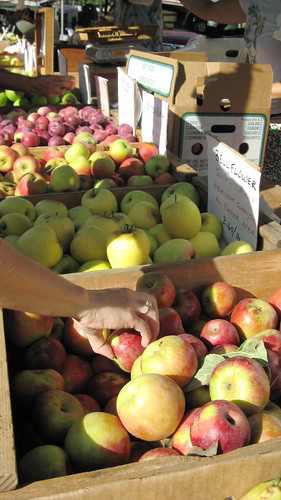
10:30 AM. My hook and go cart is heavy with newly purchased fresh goat cheese from the Farmstead Artisan goat cheese makers; apple cider and squash from Rocky Canyon; spinach and herbs from Maggie’s Farm; and heirloom zebra tomatoes from Munak.
10:45 AM. Thanks to some help from Eddie, the kindly butcher that put aside some organic duck breast for me, the trip Whole Foods of Santa Monica for protein and hard to find ingredients is a success. With a budget of $100 each, Leah and I have successfully purchased fresh, beautiful and straight-from-the-source ingredients for us to feed three courses to five judges.
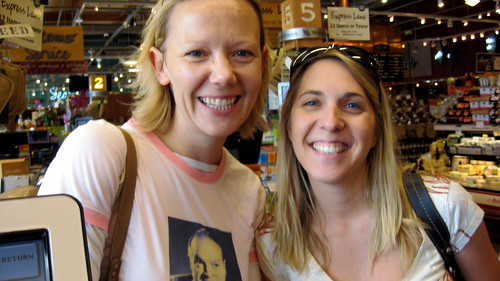
12 AM. Arrive at our version of kitchen stadium: my friend Pilar’s house. Leah and I unload my kitchen suitcase filled with cooking gear and bagged pantry items from my car. From her trunk we pull a wine crate packed with knives, mixing bowls and serving utensils and a cardboard box filled with dishes. Once inside the large kitchen, we claim a side of the marble-topped kitchen island and begin organizing our cooking stations.
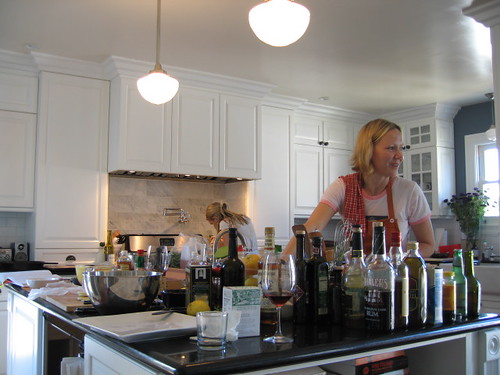
1 PM. Our esteemed panel of judges arrives.

The judges–food professionals, a restaurant publicity maven and a food lover–discuss voting procedure, the ethics of dressing dogs in cute outfits and food culture while Leah and I finalize the organization of our menus.
1:10 PM. Nick, one of our judges, flips a coin to decide which blogger will begin cooking. With a thirty-minute window between the two of us, the kitchen will be free to each chef for thirty minutes and each will have a chance to present their food without losing the dishes’ integrity.
ALLEZ-CUIZINE!
I watch Leah furiously begin chopping apples. I smile at her as she works. Her face is tight with concentration. She rarely looks up from her cutting board. I try to make conversation with the judges, but really, I’m thinking about the time. I watch the digital numbers on my wrist as I wait for:
1:40 Based on my time line and planned menu, I decide to prep and cook my butternut squash puree first. I slice away at the tough skin as I watch Leah drape cheesecloth over a plastic prep container and note the rising temperature of the raw milk she’s poured into a stockpot. As she checks the thermometer on the pot, I gasp when I realize what she’s doing. Leah is making cheese.
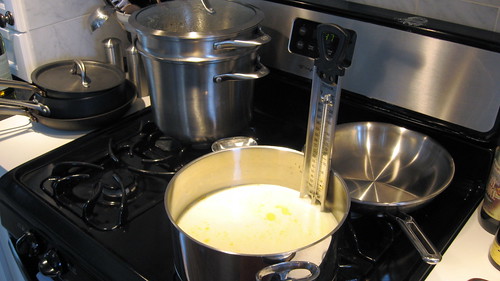
While the clock starts to tick away at my prep time, I mix up a blend of apple cider, calvados, Averna and dark rum. I pour it over ice with a nickel-sized slice of lemon zest and serve it to the judges (before judging has even begun) as an apertif. The judges clink glasses with me and take a sip. Mulled apples, pie spices and toast coat my tongue and sends my heart racing. But there’s no time for drinking cocktails. I’ve got cooking to do.

Leah zips past me as I stand at the stove. She washes a pot at the sink and returns it to one of her two burners at the four-burner stove. I watch her begin what looks like an apple risotto. Her smile confirms it as I give her a high five for choosing such high-difficulty dishes.
“Looks like the competitors are much too friendly,” notes one of the judges.
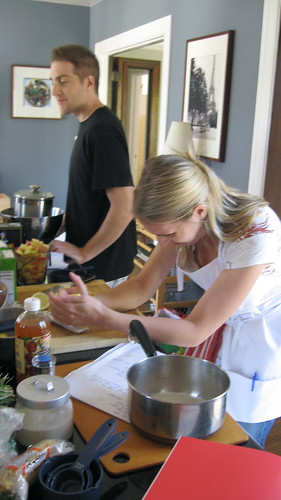
Time shape shifts as I prepare my dishes. There’s a calm that’s come over me. The swirl of sound as the judges speak disappears as I prepare the duck breasts. I slice away at unwanted textures of bone or connective tissue as I replay the memory of the kitchen prep I’ve watched in restaurant back kitchens. I set the mental image of my kitchen heroes and mimic their knife technique. I slice cross patterns into the fat of the duck and admire the patterns of white skin and crimson meat.
Despite the growing level of excitement in the kitchen, I find myself slipping into an almost meditative state. I prepare an apple gastrique and still have time to marvel at the syrupy texture of the sauce. I taste flavors of the veal stock, the sweet and tart of the apple, the balance of salt to pepper. I enjoy the nuanced colors of the apple as they caramelize in the pan. Despite the pressures of time, I find myself enjoying the beauty of cooking a new dish.
It must be my well-seasoned cast iron skillet making me feel this confident. Using a battle-axe of a fry pan, I feel like a confident toddler with a security blanket. I turn up the flame on my skillet until I can feel the heat on the palm of my hand when I hold it just above the pan’s coal-black surface. I toss the duck breasts onto the hot metal and listen to the hiss of meat searing.
My calm waivers while pureeing a cooked butternut squash and apples. Orange pulp splatters the white cabinets like a Pollack painting as my hand held mixer breaks in half. I ditch the immersion blender.
3:40 PM. I pull chilled plates from the refrigerator and begin plating my composed spinach salad. I toss the greens in salt and pepper, drizzle the leaves with a Spanish olive oil and then drizzle the salad with lemon juice and apple cider vinegar. I plate the greens and add the artisan goat cheese, candied nuts, and sautéed Bellewether green apples. I toss the quartered, green heirloom tomatoes in lemon juice and olive oil (just like Alice Waters taught me to do in her Café Cookbook) and add them to the salad. I question my choice of apples and green tomatoes for a moment, and decide to stick with my original plan.
I slice the duck breast and discover the meat is cooked pink all the way through. The meat looks exactly as I wanted it, but the duck’s fatty layer remains. I decide against trying to render off the duck fat, for fear of overcooking the meat.
I finish caramelizing apples with cream and sugar as the judges demand the next course. I add a splash of Calvados from a Normandy and grab the store bought gelato (a cheat, I know) from the freezer. As the last few seconds tick away, I realize the plates I planned to use are much too big. I become frantic as I search my host’s cabinets for smaller dishes. I snatch tea cups from the shelves and claw clumsy balls of vanilla ice cream from the frozen solid pint container. The ice cream scoop hits the floor and I let out an audible yelp.
My husband steps in to pluck the scoop off of the floor. There’s another call for my third and final course. I’m not going to make it! Forget about perfect quenelles of ice cream. I toss the ice cream into tea cups and rush to the judges table. So much for my zen like calm.
My Dishes
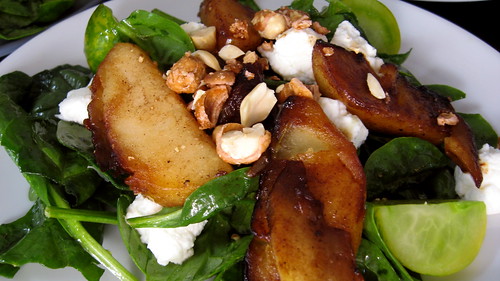
Spinach and Bellflower apple salad with Farmstead Artisan Goat Cheese, candied peanuts and green heirloom tomatoes
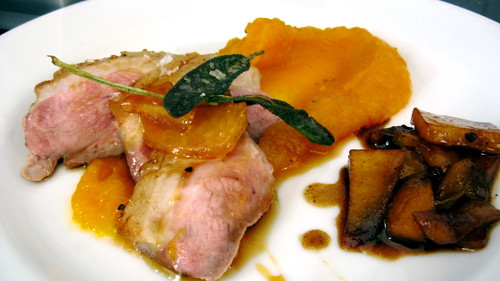
Pan seared duck breast with Jonalicious gastrique, pureed apple and butternut squash, and candied apples
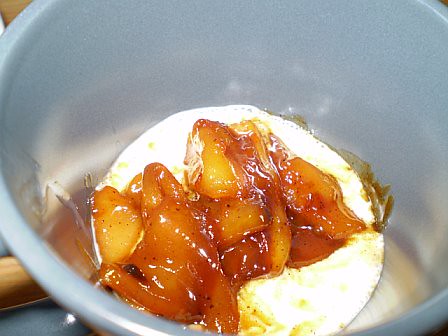
Naked Pie: Caramelized Spizenburg apples with Calvados and vanilla ice cream
While the judges deliberate, Leah and I stand in the kitchen like two shell-shocked warriors. We share appreciatory smiles while we hungrily chew the extra scraps from our dishes. We’re tired, exhausted, hungry and in need of a drink. Water or alcohol, it doesn’t matter. Something. Anything.
The judges call us to the table for the final judgment. The scores (plating, originality and taste) have been tallied.

“The judges have decided. It was a very close race. With the winning score of 68 points, the winner is…”
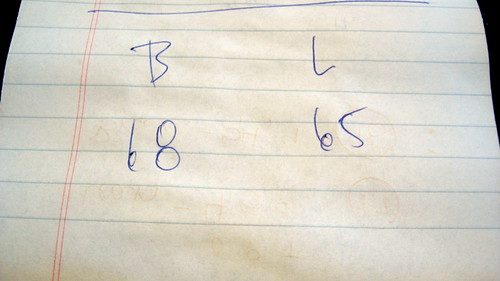
The judges announce my name and my face flushes. I can’t believe it. I’ve won? But what about the lacking salt on the duck? The choice of greens in my salad? The big tea cup instead of a bowl for my dessert?
I scan the judging cards and see the numbers all add up. I won by three taste points.
Leah and I take a seat at the judges’ table to taste what remains of the dishes after two judges leave before they’re late for a night of service at their busy restaurant jobs. It’s the first chance we’ve had all day to sit down and relax.
It’s wonderful tasting Leah’s apple dishes. Her palate cleansing apple and fennel salad is refreshingly simple. The perfectly cooked Pork loin with its sweet and spicy relish is by far the best savory course of them all. The doughy fritter, delicate cheese drizzled with honey reminds me of a sophisticated fairground dessert. Even though I feel a sense of pride for winning, I know we both have won. The element of competition raised our game, made us better chefs and inspired us to take chances.
After facing the heat of our make-shift kitchen stadium, Leah and I–two food bloggers, writing partners, featured publishers and, most importantly, friends—are still just as unified as ever. Maybe even more unified than before.
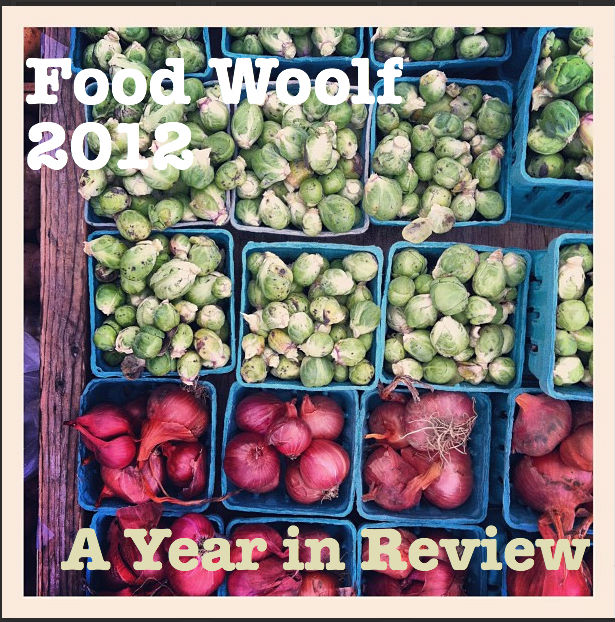 It may not be best to dwell in the past, but it doesn’t hurt to look back and appreciate all that’s happened. So rather than write a post featuring top recipes or big news stories of the year, I thought I’d take a little time to write something of a gratitude list for this blog in 2012. It has been an eventful time filled with great lessons, delicious recipes, and outstanding moments for me and my family. I hope you don’t mind me sharing them with you!
It may not be best to dwell in the past, but it doesn’t hurt to look back and appreciate all that’s happened. So rather than write a post featuring top recipes or big news stories of the year, I thought I’d take a little time to write something of a gratitude list for this blog in 2012. It has been an eventful time filled with great lessons, delicious recipes, and outstanding moments for me and my family. I hope you don’t mind me sharing them with you!
